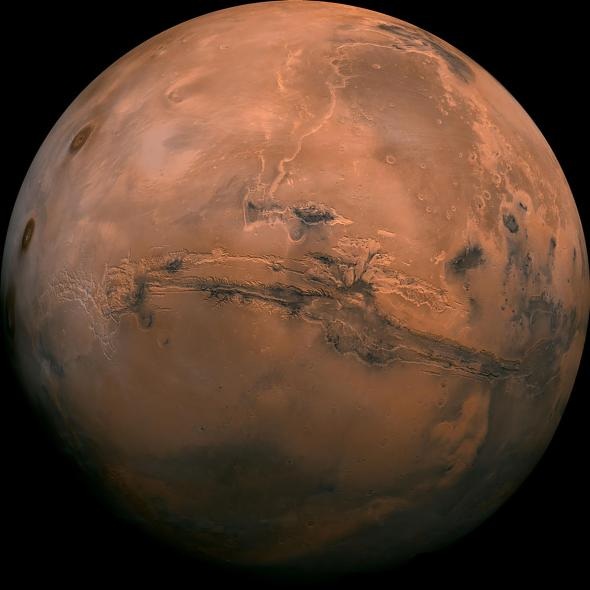This Week’s Night Sky: See the Red Planet for Yourself

Mars Primetime. As the European ExoMars orbiter mission gets underway on Monday, March 14, skywatchers get a chance to see Mars in the night sky.
Look for the red planet in the southern sky just before local dawn. It should be easy to find with the naked eye in the constellation Scorpius, as it glows distinctly orange-red and forms the upper right corner of an upside-down triangle, with yellow Saturn to its left and orange-hued Antares below.
Grab a small telescope and using high magnification to look for surface features, like the white polar caps on its tiny 10 arc-seconds-wide disk. Amazing to think humans have rovers and orbiters at Mars which is nearly 84 million miles (135 million kilometers), or seven light-minutes away from Earth.
Jovian Shadow Play. Starting late night on Monday, March 14, skywatchers with backyard telescopes can catch two of Jupiter’s largest moons cast their shadows on the gas giant.
Both Io and Europa’s tiny round shadows will appear to glide across Jupiter’s cloud tops from 10:22 p.m. EDT to 12:34 am EDT. As an added observing challenge, under high magnification, try looking for the cosmic cyclone that is twice the size of the Earth, known as the Great Red Spot. It should be visible crossing the center of the planet’s disk at 12:49 a.m. EDT.
Spring Equinox. Astronomically speaking, the Vernal Equinox, occurring March 20 at 12:30 a.m. EDT (04:30 GMT), marks one of the four major turning points in the cycle of seasons for our planet.
As our planet travels around the sun, the equinox marks the point where the Earth’s axis is neither tilted away (winter) nor towards (summer) the sun. The word equinox comes from Latin meaning “equal night” and it’s on this day that light and dark appear to be about the same length—roughly a twelve-hour-long day and night.
While it may still seem like winter for some in the Northern Hemisphere, we can take heart that Earth will warm up as the mid-day sun climbs higher and the days continually get longer.
Stellar Jewel Box. After darkness falls on Friday, March 18, look for the waxing gibbous moon high in the southeast, pointing to the nearby pretty star cluster Messier 67.
Remember that the glare coming off the moon may make the cluster fainter than usual, so if you don’t see it, try again later in the week when skies are darker. Shining at magnitude 6.1 and about the size of the moon’s disk in the sky, M67 appears bright in any binoculars and shows beautiful chains of stars. In reality, it measures some 12 light-years across and sits about 2,600 light-years away from Earth.
Astronomers believe this star cluster may be one of the oldest known, estimated to be about three to five billion years old—perhaps just a bit younger than our own sun.
Clear skies!
More:http://news.nationalgeographic.com/2016/03/160314-astronomy-stargazing-night-sky-moon-planets-star0/

